Abstract
Eubacterium limosum was isolated as the most numerous methanol-utilizing bacterium in the rumen fluid of sheep fed a diet in which molasses was a major component (mean most probable number of 6.3 X 10(8) viable cells per ml). It was also isolated from sewage sludge at 9.5 X 10(4) cells per ml. It was not detected in the rumen fluid of a steer on a normal hay-grain diet, although Methanosarcina, as expected, was found at 9.5 X 10(5) cells per ml. The doubling time of E. limosum in basal medium (5% rumen fluid) with methanol as the energy source (37 degree C) was 7 h. Acetate, cysteine, carbon dioxide, and the vitamins biotin, calcium-D-pantothenate, and lipoic acid were required for growth on a chemically defined methanol medium. Acetate, butyrate, and caproate were produced from methanol. Ammonia or each of several amino acids served as the main nitrogen source. Other energy sources included adonitol, arabitol, erythritol, fructose, glucose, isoleucine, lactate, mannitol, ribose, valine, and H2-CO2. The doubling time for growth on H2-CO2 (5% rumen fluid, 37 degree C) was 14 h as compared with 5.2 h for isoleucine and 3.5 h for glucose. The vitamin requirements for growth on H2-CO2 were the same as those for methanol; however, acetate was not required for growth on H2-CO2, although it was necessary for growth on valine, isoleucine, and lactate and was stimulatory to growth on glucose. Acetate and butyrate were formed during growth on H2-CO2, whereas branched-chain fatty acids and ammonia were fermentation products from the amino acids. Heat tolerance was detected, but spores were not observed. The type strain of E. limosum (ATCC 8486) and strain L34, which was isolated from the rumen of a young calf, grew on methanol, H2-CO2, valine, and isoleucine and showed the same requirements for acetate as the freshly isolated strains.
Full text
PDF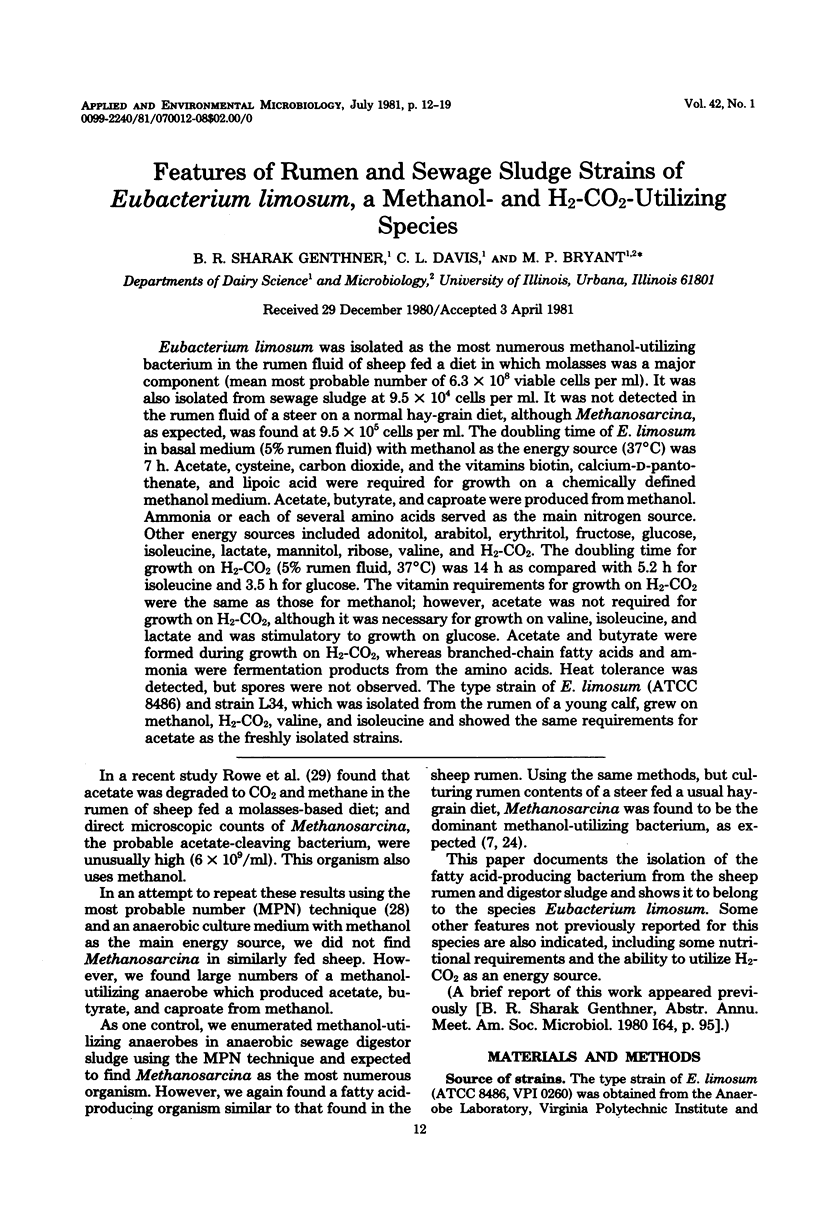
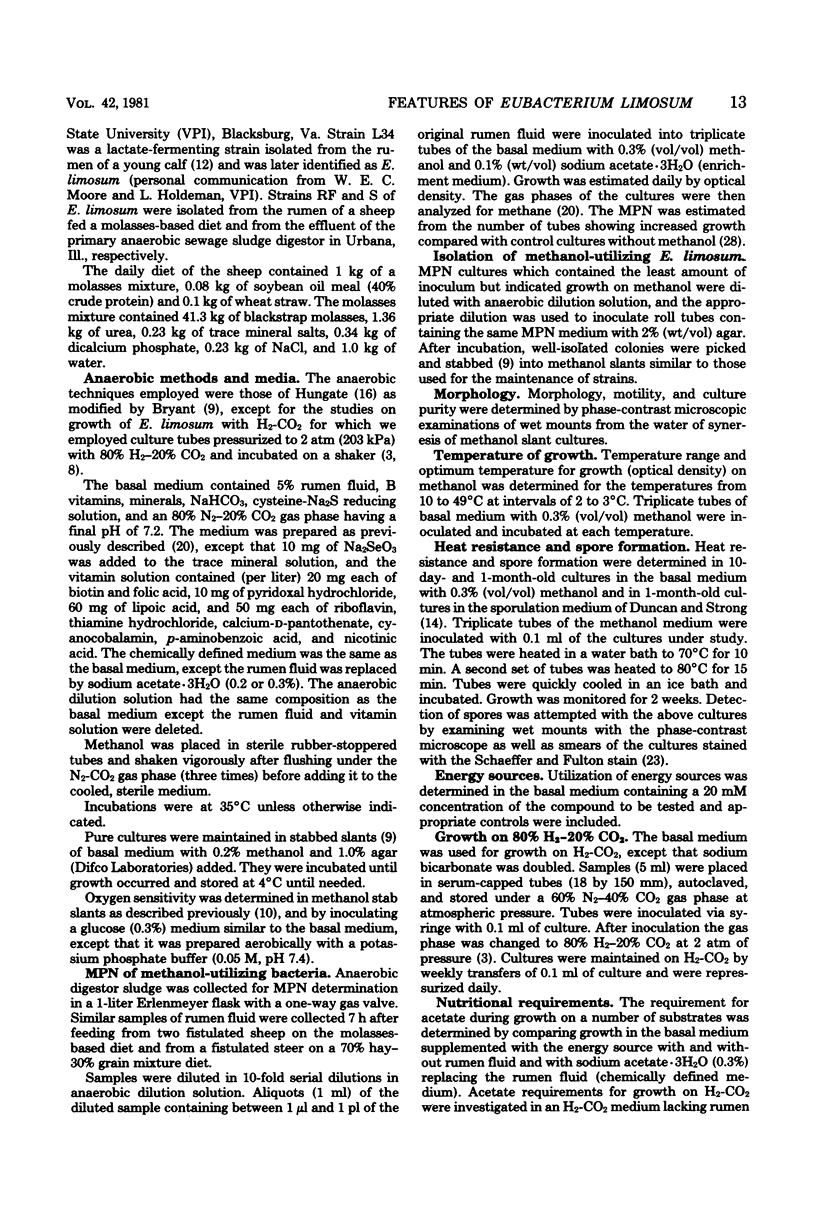
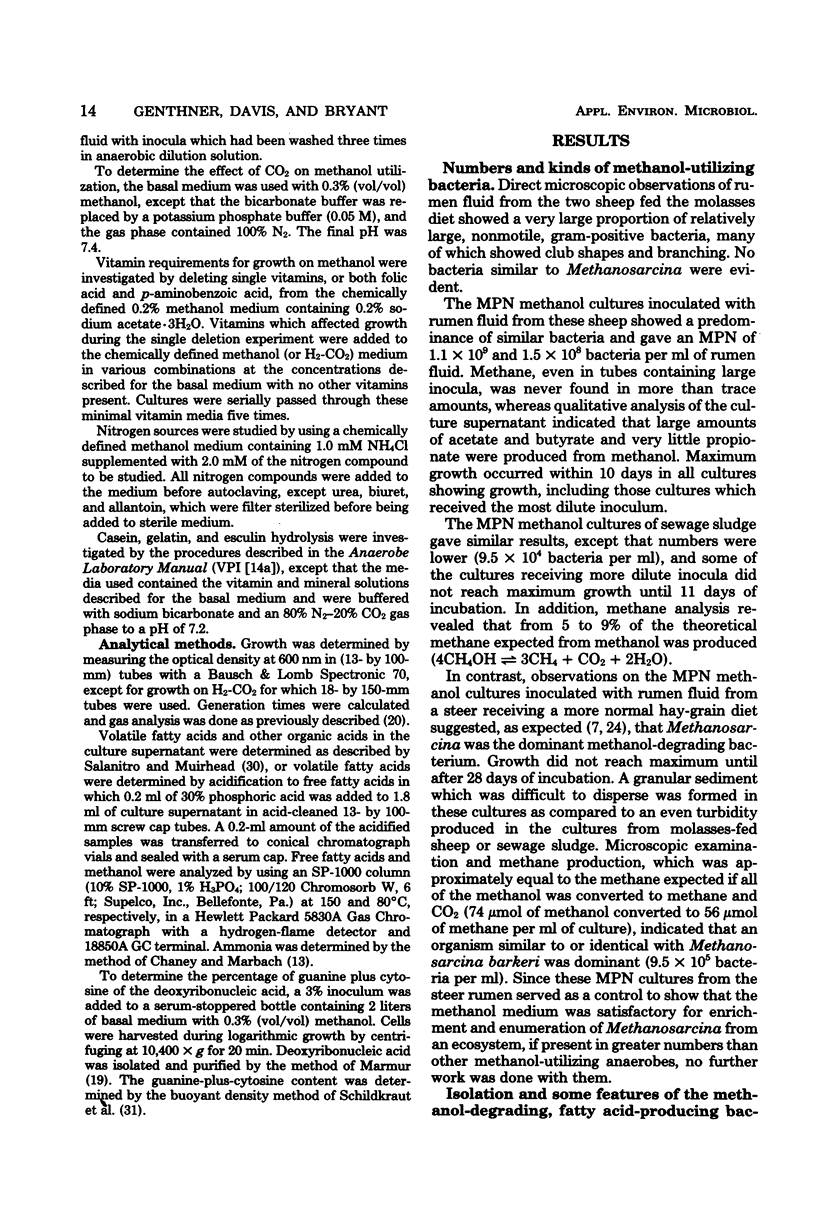
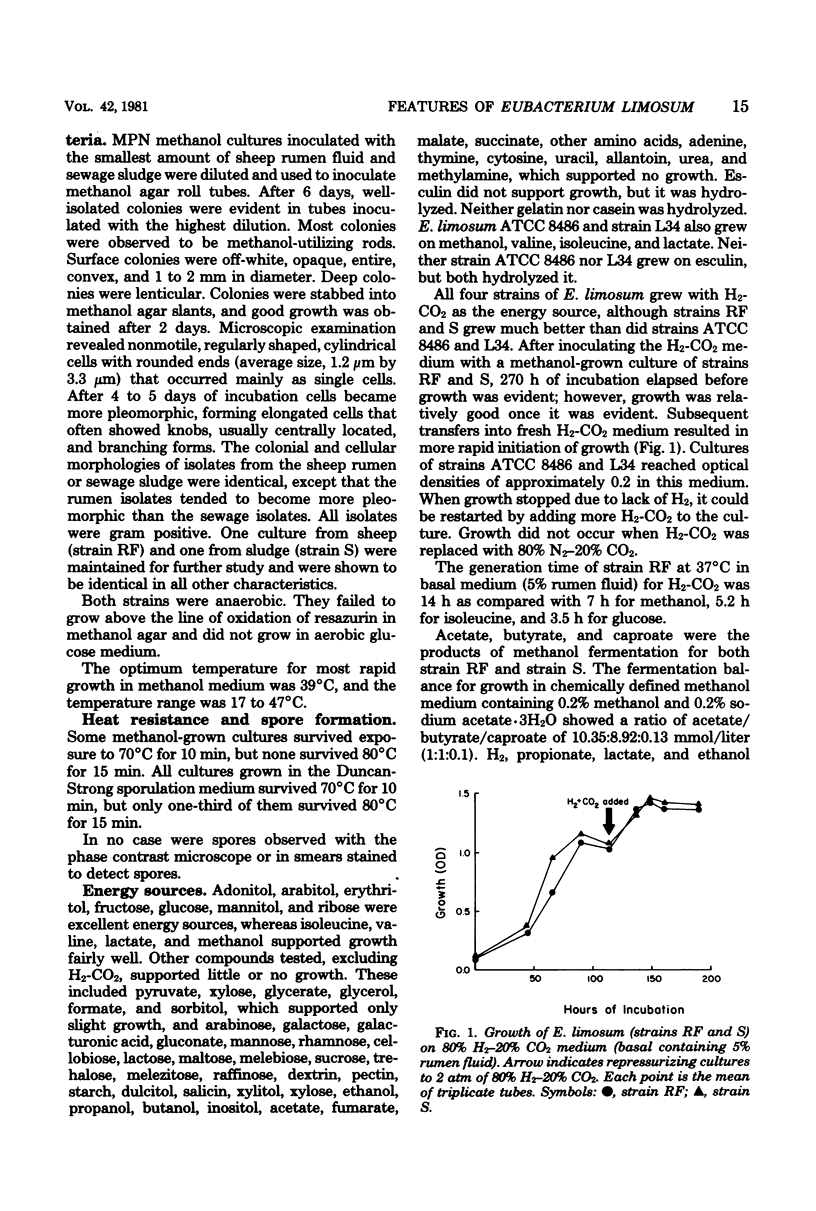
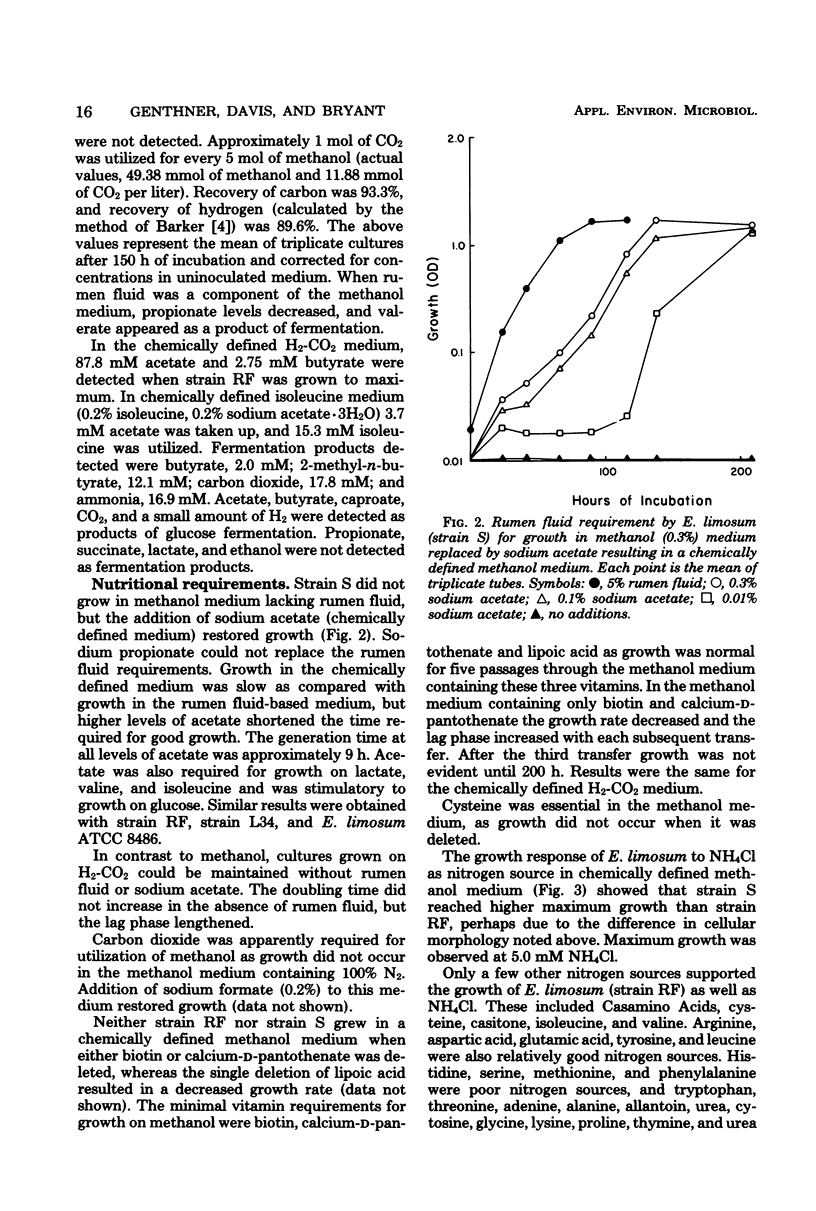
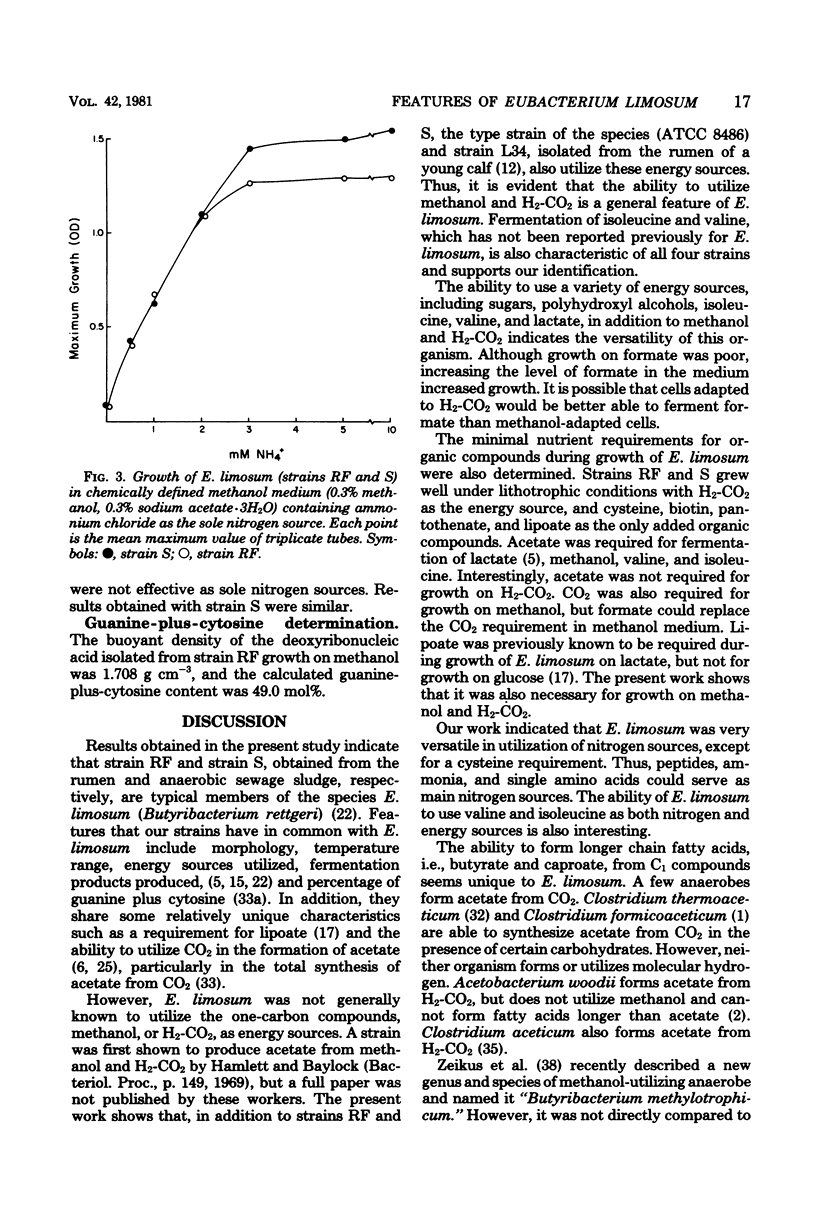
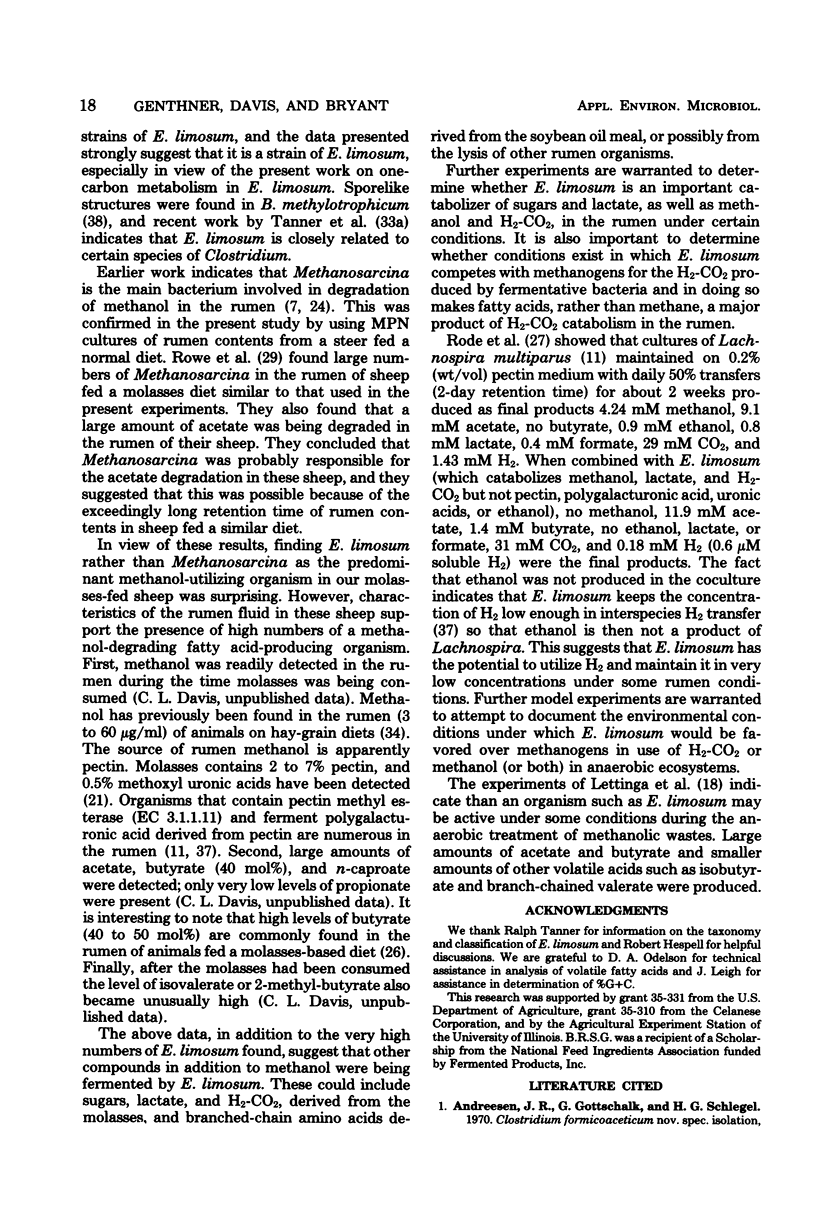
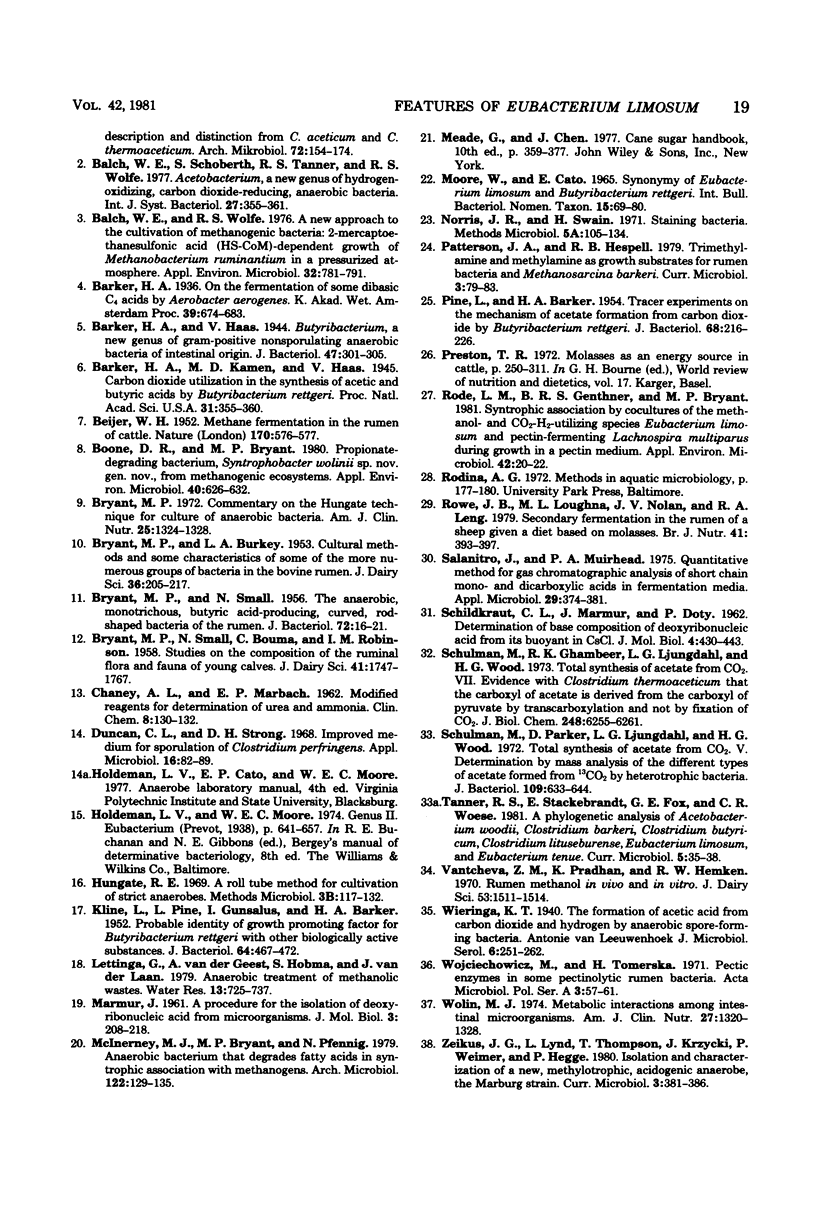
Selected References
These references are in PubMed. This may not be the complete list of references from this article.
- Andreesen J. R., Gottschalk G., Schlegel H. G. Clostridium formicoaceticum nov. spec. isolation, description and distinction from C. aceticum and C. thermoaceticum. Arch Mikrobiol. 1970;72(2):154–174. doi: 10.1007/BF00409521. [DOI] [PubMed] [Google Scholar]
- BEIJER W. H. Methane fermentation in the rumen of cattle. Nature. 1952 Oct 4;170(4327):576–577. doi: 10.1038/170576a0. [DOI] [PubMed] [Google Scholar]
- BRYANT M. P., SMALL N. The anaerobic monotrichous butyric acid-producing curved rod-shaped bacteria of the rumen. J Bacteriol. 1956 Jul;72(1):16–21. doi: 10.1128/jb.72.1.16-21.1956. [DOI] [PMC free article] [PubMed] [Google Scholar]
- Balch W. E., Wolfe R. S. New approach to the cultivation of methanogenic bacteria: 2-mercaptoethanesulfonic acid (HS-CoM)-dependent growth of Methanobacterium ruminantium in a pressureized atmosphere. Appl Environ Microbiol. 1976 Dec;32(6):781–791. doi: 10.1128/aem.32.6.781-791.1976. [DOI] [PMC free article] [PubMed] [Google Scholar]
- Barker H. A., Haas V. Butyribacterium, a New Genus of Gram-positive, Non-sporulating Anaerobic Bacteria of Intestinal Origin. J Bacteriol. 1944 Mar;47(3):301–305. doi: 10.1128/jb.47.3.301-305.1944. [DOI] [PMC free article] [PubMed] [Google Scholar]
- Barker H. A., Kamen M. D., Haas V. Carbon Dioxide Utilization in the Synthesis of Acetic and Butyric Acids by Butyribacterium Rettgeri. Proc Natl Acad Sci U S A. 1945 Nov;31(11):355–360. doi: 10.1073/pnas.31.11.355. [DOI] [PMC free article] [PubMed] [Google Scholar]
- Boone D. R., Bryant M. P. Propionate-Degrading Bacterium, Syntrophobacter wolinii sp. nov. gen. nov., from Methanogenic Ecosystems. Appl Environ Microbiol. 1980 Sep;40(3):626–632. doi: 10.1128/aem.40.3.626-632.1980. [DOI] [PMC free article] [PubMed] [Google Scholar]
- Bryant M. P. Commentary on the Hungate technique for culture of anaerobic bacteria. Am J Clin Nutr. 1972 Dec;25(12):1324–1328. doi: 10.1093/ajcn/25.12.1324. [DOI] [PubMed] [Google Scholar]
- CHANEY A. L., MARBACH E. P. Modified reagents for determination of urea and ammonia. Clin Chem. 1962 Apr;8:130–132. [PubMed] [Google Scholar]
- Duncan C. L., Strong D. H. Improved medium for sporulation of Clostridium perfringens. Appl Microbiol. 1968 Jan;16(1):82–89. doi: 10.1128/am.16.1.82-89.1968. [DOI] [PMC free article] [PubMed] [Google Scholar]
- KLINE L., PINE L., GUNSALUS I. C., BARKER H. A. Probable identity of the growth promoting factor for Butyribacterium rettgeri with other biologically-active substances. J Bacteriol. 1952 Oct;64(4):467–472. doi: 10.1128/jb.64.4.467-472.1952. [DOI] [PMC free article] [PubMed] [Google Scholar]
- PINE L., BARKER H. A. Tracer experiments on the mechanism of acetate formation from carbon dioxide by Butyribacterium rettgeri. J Bacteriol. 1954 Aug;68(2):216–226. doi: 10.1128/jb.68.2.216-226.1954. [DOI] [PMC free article] [PubMed] [Google Scholar]
- Rode L. M., Genthner B. R., Bryant M. P. Syntrophic Association by Cocultures of the Methanol- and CO(2)-H(2)-Utilizing Species Eubacterium limosum and Pectin-Fermenting Lachnospira multiparus During Growth in a Pectin Medium. Appl Environ Microbiol. 1981 Jul;42(1):20–22. doi: 10.1128/aem.42.1.20-22.1981. [DOI] [PMC free article] [PubMed] [Google Scholar]
- Rowe J. B., Loughnan M. L., Nolan J. V., Leng R. A. Secondary fermentation in the runen of a sheep given a diet based on molasses. Br J Nutr. 1979 Mar;41(2):393–397. doi: 10.1079/bjn19790048. [DOI] [PubMed] [Google Scholar]
- SCHILDKRAUT C. L., MARMUR J., DOTY P. Determination of the base composition of deoxyribonucleic acid from its buoyant density in CsCl. J Mol Biol. 1962 Jun;4:430–443. doi: 10.1016/s0022-2836(62)80100-4. [DOI] [PubMed] [Google Scholar]
- Salanitro J. P., Muirhead P. A. Quantitative method for the gas chromatographic analysis of short-chain monocarboxylic and dicarboxylic acids in fermentation media. Appl Microbiol. 1975 Mar;29(3):374–381. doi: 10.1128/am.29.3.374-381.1975. [DOI] [PMC free article] [PubMed] [Google Scholar]
- Schulman M., Ghambeer R. K., Ljungdahl L. G., Wood H. G. Total synthesis of acetate from CO2. VII. Evidence with Clostridium thermoaceticum that the carboxyl of acetate is derived from the carboxyl of pyruvate by transcarboxylation and not by fixation of CO2. J Biol Chem. 1973 Sep 25;248(18):6255–6261. [PubMed] [Google Scholar]
- Schulman M., Parker D., Ljungdahl L. G., Wood H. G. Total synthesis of acetate from CO 2 . V. Determination by mass analysis of the different types of acetate formed from 13 CO 2 by heterotrophic bacteria. J Bacteriol. 1972 Feb;109(2):633–644. doi: 10.1128/jb.109.2.633-644.1972. [DOI] [PMC free article] [PubMed] [Google Scholar]
- Vantcheva Z. M., Prodhan K., Hemken R. W. Rumen methanol in vivo and in vitro. J Dairy Sci. 1970 Oct;53(10):1511–1514. doi: 10.3168/jds.s0022-0302(70)86424-4. [DOI] [PubMed] [Google Scholar]
- Wojciechowicz M., Tomerska H. Pectic enzymes in some pectinolytic rumen bacteria. Acta Microbiol Pol A. 1971;3(1):57–61. [PubMed] [Google Scholar]
- Wolin M. J. Metabolic interactions among intestinal microorganisms. Am J Clin Nutr. 1974 Nov;27(11):1320–1328. doi: 10.1093/ajcn/27.11.1320. [DOI] [PubMed] [Google Scholar]


